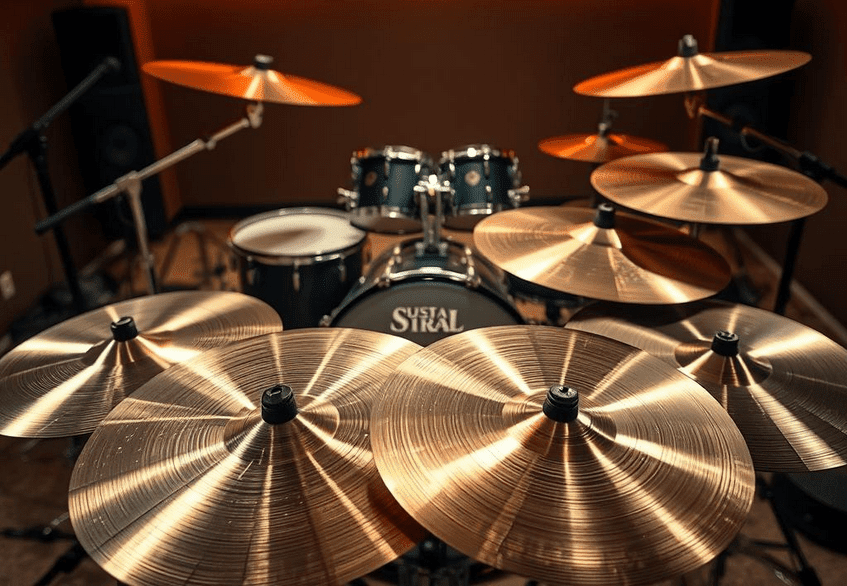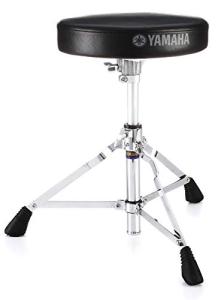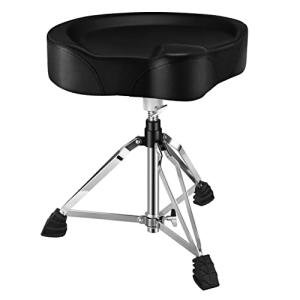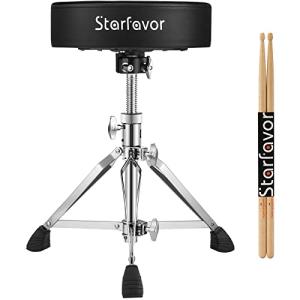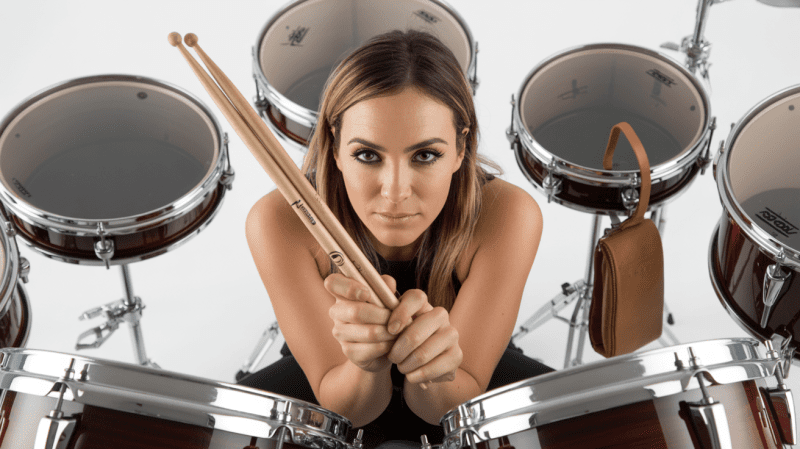Creative Ways to Use Splash Cymbals in Your Playing

I love how a small splash can change the feel of a song. A splash cymbal produces a quick, bright voice that pops without overwhelming the mix. It adds accents and color that lift grooves and support the band.
I’ll explain what a splash is on my kit and why I reach for this thin, fast-attack piece when I want short, defined accents. I show how I use a splash for tight crash punctuation, staccato figures, and delicate details that sit on top of my hats and ride.
I also cover how I shape the sound with touch and placement so the cymbal supports the drum voice. Expect practical tips on size, material, ergonomic setup, and simple tricks, such as stacks and micro-fills, that add a lot of flavor. Small cymbals can make a significant difference in dynamics and arrangement when used intentionally.
Key Takeaways
- Splash cymbals deliver short, bright accents that don’t overpower the mix.
- Use touch and placement to shape tone and control decay.
- Try the splash for quick crash punctuation and staccato figures.
- Choose size and material to expand your tonal palette.
- Stacks and micro-fills add flavor without cluttering the kit.
- When used intentionally, a splash boosts feel, space, and arrangement.
Why I Add a Splash to My Drum Kit for Dynamics, Accents, and Color
https://www.youtube.com/watch?v=P7zfiEArI3Y
A tiny splash on the kit gives me precise control over moments that need a little lift. The small cymbal footprint allows me to play quick events that add life without overwhelming the mix.
Enhanced dynamics: subtle accents without overwhelming the mix
I add a splash because tiny taps create a quick sound that tucks behind the ride and hats. Firmer strokes bring out a bright accent that cuts without masking other parts.
Expanding my tonal palette with unique sounds and textures
Different alloys and sizes give me more cymbals and splashes to choose from. That variety helps me match the emotion of a section and add lot of color where needed.
Creative possibilities: weaving quick crashes and effects into grooves
I weave short crashes between snare backbeats and ghost notes for momentum. As an example, a soft splash on the “&” of 4 every other bar lets a verse breathe while the groove stays steady.
- Control: ergonomic placement keeps accents in time.
- Clarity: short decay means I can play often without clutter.
- Transition tool: a flick of the splash colors moves without a full crash.
Choosing the Right Splash Cymbal: Types, Sizes, Materials, and Budget

Choosing a splash is about matching a tiny voice to the songs you play. I size my options against the role I need: a quick accent, a trashy bite, or a flexible effect that stacks well.
Types and voices
Traditional splashes are usually 8" or smaller, thin and bright—perfect for fast attack and short decay.
China splash models (often 10" or larger) give a darker, trashier bite for rock and heavier music.
Stackable and multi-splash designs allow me to layer and achieve multiple sounds from a single mount.
Sizes, profiles, and materials
I favor 6–8" for ultra-tight pops and a 10" china-style profile when I want a gnarlier voice that still clears quick.
Brass pushes brighter, punchier cuts. B20 bronze sounds warmer and blends better with rides and snares.
Lathed finishes emphasize definition; unlathed cymbals sit smoother and softer in a mix.
Budget and practical tips
Starter splashes are fine for learning attack and placement. Pro-grade cymbals give richer overtones and consistency for recording.
Consider stands and stacking holes—some cymbal pairs form better stacks, which alter both the feel and sound.
| Feature | Typical Size | Typical Sound | Best For |
|---|---|---|---|
| Traditional splash | 6–8 in | Bright, fast attack | Pop, funk, tight accents |
| China splash | 10 in+ | Trashy, darker bite | Rock, metal accents |
| Stackable / Multi-splash | Varied | Modular, layered sounds | Experimental rigs, studio effects |
| Materials | Brass / B20 | Bright vs. warm | Match to kit and genre |
- Listen to candidates with your snare and hats, not alone.
- Match material and finish to the music you play most.
- Buy the splash that supports your voice, not just the specs.
Smart Setup: Where I Place Splashes Around Hats, Ride, and Toms

Finding the right spot for a splash on my kit makes accents feel natural and effortless. Ergonomics matter: a good setup keeps my hands relaxed and my time steady.
Go-to spot
My default placement is between the hats and the ride, slightly above snare height. I can tag the splash quickly without changing my stick path or breaking time.
Alternative setups
I mount a splash above a rack tom when I want tight tom-to-splash moves during fills. That makes fast hits feel musical and connected to the tom voice.
For isolation, I put the cymbal on a separate stand with a short boom. This gives angle control and keeps sympathetic vibrations down.
- Clamp mounting: attach off the ride or hats stand to save space on small kits.
- Stacking: pair a splash over a thin crash for a drier, aggressive sound.
- Placement tip: set the edge at the top of your natural stick arc so accents come without reaching.
Ultimately, the best setup is the one that lets you hit the splash instinctively while keeping your core motion centered on snare, hats, and ride.
My Go-To Techniques: From Quick Accents to Effects That Cut
When a bar needs a flick of brightness, I reach for a splash and a precise stroke. These moves let me shape small moments that push a song forward without crowding the mix.
Short, sharp accents and staccato punctuation in time
I strike near the edge with a glancing motion so the splash speaks fast and dies quick. I use tight staccato patterns—single strokes and tiny doubles—to add punctuation that sits with the snare and hats.
Rolls and swells for building tension and release
For swells, I roll the tip around the rim and slowly increase velocity. The resulting rise gives a soft build that leads into choruses or fills without needing a full crash.
Muting with hand or dampening for controlled, dry textures
I often rest my non-stick hand on the bell or edge to mute instantly. That dry tick adds texture and keeps the cymbal from washing out the arrangement.
Ride-plus-splash combinations: unison hits and layered patterns
I pair the ride and splash on downbeats so the ride anchors the pulse and the splash adds a bright flicker. Sliding from muted taps into an open hit creates a subtle tension release within a bar.
"These small techniques let me color the music in meaningful ways without overpowering vocals or guitars."
Creative Ways to Use Splash Cymbals in Your Playing
Small cymbal stacks can add sudden grit or shimmer that changes a groove instantly. I start with a quick stack or pairing, then shape hits with touch and mute to keep things tight.
Stack tricks: pairing for gritty effects
I place a splash over a mini-China or thin trash crash for a darker, trashy texture. This stack provides me with fast, gritty effects that suit rock or aggressive pop drops.
Call-and-response with hats and ride
I trade short tags between hats and the splash, then answer on the ride the next bar. Those little exchanges create conversational phrasing without crowding vocals.
Micro-fills and one two taps
My micro-fills are one two quick taps on the splash between tom hits. They lift energy and keep the pocket intact. A muted hit plus a rim knock can mimic hybrid drum sounds for studio work.
Timekeeping textures and live vs. studio
Feathering a soft splash on the offbeats adds motion while staying sparse. In the studio I choose a darker, thinner splash for clean takes; live, a brighter model helps the audience hear the detail over amps.
"A single, well-placed splash can mark a phrase without washing the mix."
- Tip: Offset the China-style layer so air can escape and the decay remains short.
- Tip: Keep crash hits minimal from stacks—one precise strike marks the ending.
Style Examples: Jazz, Rock, and Beyond—When I Use Splashes (and When I Don’t)
I decide which small cymbal to bring by how the arrangement breathes and where the top-end should sit.
Jazz and fusion
In jazz I let the ride lead and add delicate splashes at phrase ends. I pick a thin splash that whispers and clears fast.
For modern jazz ballads I tap the cymbal under piano voicings. The result is shimmer that supports rather than covers acoustic players.
Rock and metal
In rock I favor darker, China-leaning splashes or stacks for gritty crash punctuation that cuts through guitars. A stacked setup gives dry attack and punch for loud stages.
In metal I use a stacked splash for tight, aggressive ticks that follow fast double-kick passages without becoming a wash.
Minimalist mindset and other styles
I remind myself: you can play a big gig without one. The song comes first, and the tool is optional.
My rule is needs over wants. If I keep hearing that quick top-end accent in my head, I bring the cymbal; if not, I leave it off the kit for clarity.
- Folk/singer-songwriter: one or two tasteful tags per song.
- Funk / R&B: tiny offbeat splashes to lift the pocket.
- Worship / cinematic: darker splash that blends with pads for atmosphere.
"Across styles I let the arrangement decide—play it when it serves the music, skip it when it doesn't."
Conclusion
Adding a splash carefully can sharpen phrasing and give a kit a distinct top-end voice. I wrap up by saying that choosing the right types and sizes is about taste and the song’s needs.
If you’re looking to expand a cymbal set, start with a thin 6–8" for quick articulation, then add a darker option for contrast and unique sounds. Mount one between the hats and ride. Keep a second near the rack, and put a stack on a side stand for effect.
Quick checklist: style, volume, mic setup, and feel. Practice one, two micro-fills, hand mutes, and dynamic ladders. Sample a few pieces, commit to the one that makes the biggest difference, and build your palette slowly.
With intention and a light touch, this small cymbal helps phrases land, adds texture, and makes a real difference in how your set sounds over time.
FAQ
Why do I add a splash to my kit for dynamics and accents?
I add a small cymbal because it gives quick, bright punctuation without drowning the mix. It helps me place subtle accents and lift phrasing at key moments, so fills and transitions feel more intentional.
What kinds of splash-like options should I consider for different voices?
I look at traditional splashes, China-style splashes, stackable pieces, and multi-splash mini-sets. Each voice ranges from clean and bell-like to trashy and short — I pick one that complements my ride and crashes.
Which sizes work best for fast, bright hits versus trashier tones?
I usually grab 6–8-inch splashes for fast, bright punctuation and 10-inch models when I want a wider, grittier sound. Smaller diameters produce a sharper cut; larger ones yield a bit more sustain and character.
How do materials and finishes change the sound?
Bronze (B20) splashes add complex overtones and musical warmth, while brass is brighter and more vibrant. Lathed finishes open up sustain; raw or unlathed faces sound drier and trashier. I choose based on whether I need shimmer or bite.
Are there any tips for buying on a budget versus opting for pro-grade equipment?
I recommend trying a starter brass splash to learn its role, then upgrade to a B20 when you need more tonal nuance. Used cymbals from brands like Zildjian, Sabian, or Meinl can be smart, cost-effective choices.
Where do I place splashes for quick access during grooves?
I mount mine between the hi-hat and ride for ergonomic hits. That spot makes one-handed accents and unison patterns easy, without requiring me to reach over toms or move my setup.
What about alternative placements and stacking setups?
I sometimes put a splash above a rack tom, on its own stand, or stack it with a china or crash for trash effects. Stacking creates short, explosive sounds perfect for riffs and transitions.
How do I execute short, sharp accents and staccato punctuation?
I strike near the edge with a quick rebound, using wrist motion for snap. Keeping strokes small preserves tempo and gives a clean, cutting attack that doesn’t clutter the groove.
How can I use rolls and swells on a splash?
I use soft finger or stick rolls across the splash for tremolo-like shimmer, then open to a stick hit for release. Swells work well under builds when I want a tiny crescendo before a big crash.
What techniques work for muting or controlling sustain?
I mute with my hand or add small dampeners to shorten decay. Muting yields a dry, tight click that suits dense mixes or live stages, where excessive sustain can be muddy.
How do ride-plus-splash combinations enhance patterns?
I hit ride and splash together for a layered attack — the ride gives a wash while the splash adds immediate cut. Alternating them creates depth and rhythmic interest without significantly altering the dynamics.
How can I stack a splash with a china or trash crash for effects?
I pair a small splash on top of a china or thin crash for a gritty, fast-decaying mash-up. Tightening the top wingnut increases choke and bite, giving aggressive accents for rock and metal.
What’s a good use of call-and-response between splash and hats or ride?
I trade short phrases: a splash answer after a hat pattern or a splash punctuating a ride motif. It creates dialog within the drum kit and keeps arrangements lively without adding new instruments.
How do micro-fills using one- and two-stroke splashes help a song?
I drop one- or two-stroke splashes at phrase ends to signal transitions or emphasize lyrical cues. They’re small gestures that register strongly to listeners and keep the groove moving forward.
Can splashes be used for timekeeping textures without cluttering the groove?
Yes. I place light splashes on the “&” of beats to add motion. Keeping hits soft and sparse prevents clutter while adding sparkle and forward momentum.
How do I choose different splashes for studio work versus live shows?
In the studio, I favor splashes with defined tonal qualities and less unpredictability. Live, I might use trashier or more aggressive splashes that read well over loud stages. I always test mic placement and dampening for the room.
When do I use splashes for jazz and fusion vs. rock and metal?
For jazz and fusion, I choose delicate splashes that color the ride and add nuance. For rock and metal, I prefer darker China-style splashes or stacks that cut through heavy guitars and add impact.
Is it necessary to have a splash on every gig?
Not at all. I bring a splash when the music calls for quick color or effect. If a set is minimal or prefers open dynamics, I’ll skip it. The key is using it when it genuinely enhances the song.
